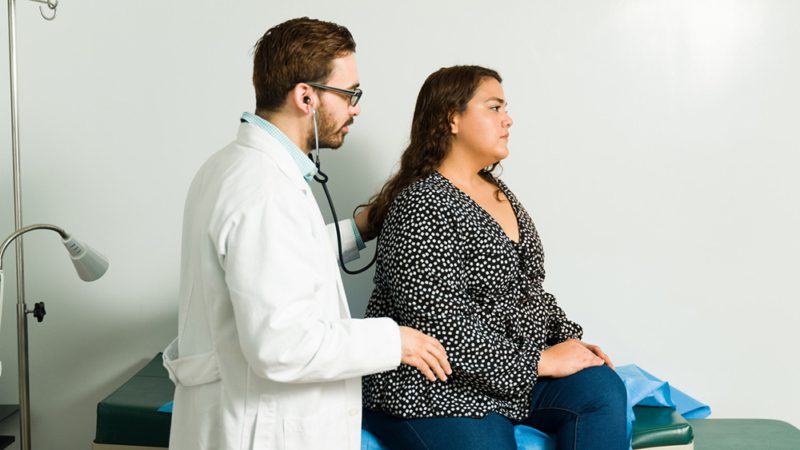Research could lead to a new way for doctors to identify Latino children and teens most at risk of developing prediabetes.
By Hope Hamashige
A team of researchers from the Keck School of Medicine of USC have identified two metabolites, substances produced by the body during metabolism, that may help predict which young Latino people are most likely to develop prediabetes, a precursor to developing type 2 diabetes.
The study, funded by the National Institutes of Health and published in Diabetes Care, is the first large-scale study to look at metabolites as possible predictors of prediabetes or type 2 diabetes in young Latino people. The researchers found that when they added these two metabolites to current prediction models, they could more accurately predict which children in the study would develop prediabetes compared to models relying only on traditional risk factors such as obesity and blood sugar levels.
Prediabetes among young people is an emerging epidemic in the U.S. that disproportionately affects Hispanic children. Jesse Goodrich, assistant professor of population and public health sciences at the Keck School of Medicine of USC and the study’s lead author, added that prediabetes and type 2 diabetes are far more serious and progress faster when they develop in childhood.
Among young people, type 2 diabetes can cause permanent damage to blood vessels, nerves, and the kidney in less time than in adults. Young people with the disease also have a shorter lifespan, by about 15 years, than the rest of the population. Existing treatments for type 2 diabetes in adults do not work as well in children.
“Preventing the development of prediabetes in these children is crucial and, unfortunately, it is difficult for doctors to identify which youth are at highest risk of developing diabetes,” said Goodrich. “We believe this research helps shed light on a potential new tool to help those children who need intervention most.”
Advanced research techniques yield new insights
The researchers used samples collected during two longitudinal studies that took place at the University of Southern California — the Study of Latino Adolescents at Risk and the Southern California Children’s Health Study. Participants included from both cohorts were overweight but did not have prediabetes or diabetes when they entered each study. Nearly 1 in 3 participants developed prediabetes or type 2 diabetes in follow-up exams.
Participants in both studies made several clinical visits to Keck Medical Center of USC where they completed glucose tolerance testing. The research team analyzed the samples from these glucose tolerance tests, using an untargeted approach to include all possible metabolites in the samples.
Using advanced machine learning, they were able to evaluate all the substances and determine which combinations or compounds best predicted which children developed prediabetes. They found that allylphenol sulfate, a metabolite related to diet, and caprylic acid, a type of fatty acid, were most predictive of prediabetes when combined with other risk factors such body weight, age, and blood sugar levels. Allylphenol sulfate is a is a phytochemical found in fruits and vegetables that is negatively associated with prediabetes and caprylic acid is a straight-chain fatty acid that may be a marker of insulin resistance.
This research also revealed that the predictors most commonly used in adults, which are insulin and blood glucose levels, do not work as well to predict prediabetes in Latino children.
“The untargeted approach allowed us to look at hundreds of different chemicals and only pick out the ones that are most important,” said Goodrich, adding that the machine learning allowed them to sort through compounds and combinations of compounds quickly. “Combining these two methods allowed us to do something that just wasn’t possible only a few years ago.”
Addressing a critical health disparity
Although prediabetes and type 2 diabetes are on the rise among all young people in the U.S., they disproportionately affect young Latino people. More than 22% of Latino youth and 28.7% of Latino young adults have prediabetes compared with 15.8% and 21% of non-Latino white young and young adults.
While Latino people have higher rates of prediabetes and type 2 diabetes than other ethnic groups, Goodrich points out that both Latino youth and adults have historically been understudied when it comes to research on diabetes.
“Including different populations is critically important to making sure that the findings don’t just apply to the people who are traditionally included in research,” said Goodrich. “It helps to improve understanding of disease and to begin to address health inequalities to focus on different populations.”
About the study
Additional authors of the study include Brittney O. Baumert, Leda Chatzi, Zhanghua Chen, David V. Conti, Frank D. Gilliland, Michael I. Goran, Sarah Rock and Hongxu Wang of the Keck School of Medicine of USC; Xin Hu, Dean P. Jones and Douglas I. Walker of Emory University; Xiangping Lin and Damaskini Valvi of the Icahn School of Medicine at Mount Sinai; Tanya L. Alderete of the University of Colorado, Boulder; and Kiros Berhane of Columbia University.
The Study of Latino Adolescents at Risk is funded by the National Institutes of Health, National Institute of Diabetes and Digestive and Kidney Diseases grant R01DK59211 and National Institute of Environmental Health Sciences (NIEHS) grant R01ES029944. The MetaAir/MetaChem study, a subset of the Southern California Children’s Environmental Health Center, was funded by NIEHS (R01ES029944), the Southern California Children’s Environmental Health Center grants funded by NIEHS (P01ES022845, 5P30ES007048, P01ES011627), the United States Environmental Protection Agency (RD83544101), and the Hastings Foundation. Additional funding from National Institutes of Health includes the National Human Genome Research Institute (NHGRI U01HG013288), the NIEHS (P30ES007048, T32ES013678, R01ES030364, R01ES030691, R21ES028903, R21ES029681, R00ES027870, R01ES033688, R21ES029328, K12ES033594, P30ES023515, U2CES030859, R01ES032831, R00ES027853, U2CES030163, P30ES019776, R24ES029490, R01ES032189, and R21ES031824), the National Institute of General Medical Sciences (R25GM143298 ), the National Cancer Institute (P01CA196569), and the National Institute on Minority Health and Health Disparities (P50MD017344).
